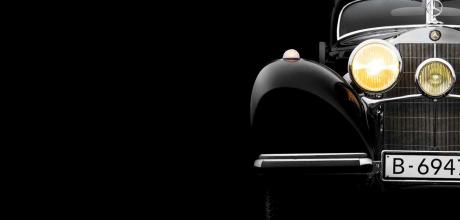1938 Mercedes-Benz 540K Autobahn-Kurier W29
This year’s winner Octane captures the winning Mercedes-Benz 540K Autobahn-Kurier at Pebble Beach; David Burgess-Wise uncovers the story behind it. Photography Evan Klein.
PEBBLE BEACH WINNER
The victorious 1938 Mercedes-Benz 540K
It’s the war of the decades!’ the live-stream pundits were beside themselves with anticipation: two post-war cars — a Ferrari and a Maserati — in the final cut of four vying for Best of Show at Pebble Beach. It was unprecedented: ‘Is the old guard getting rattled?’ pondered commentator Justin Bell. Could it be victory for the erubescent 1956 Maserati A6G Zagato Coupe of Jonathan and Wendy Segal, already winner of an elegance award?
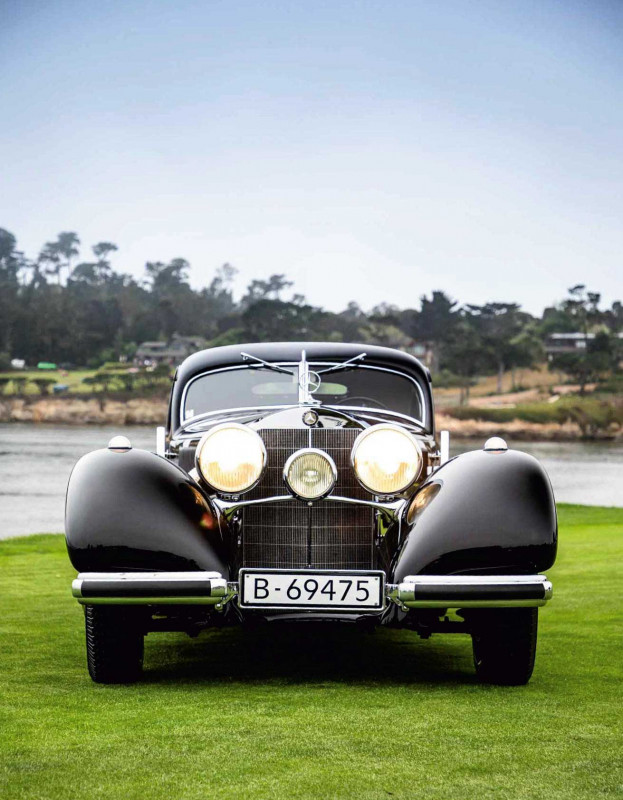
Anticipation grew as the Maserati first edged forwards to the final assembly point, peaking as master of ceremonies Derek Hill — son of the much-missed Phil Hill, who did so much to make Pebble Beach a world- class event — opened the golden envelope containing the judges’ verdicts. After all the anticipation, tradition was upheld: ‘And the 2021 Pebble Beach Concours d’Elegance winner is… the 1938 Mercedes-Benz 540K Autobahn-Kurier of Arturo and Deborah Keller!’
'The Autobahn-Kurier's sleek lines were claimed to give it a top speed of 110mph'
this was not the first time the Kellers’ gloriously understated raven-black Autobahn-Kurierhad made it to the final cut at Pebble Beach: it was a qualifier for Best of Show fresh out of restoration back in 2006, though that year the ultimate accolade went to a 1931 Daimler Double-Six 50 Corsica Drophead Coupe. Under the strict rules of the Pebble Beach Concours, cars are not allowed to return to the show field within a ten-year period unless they have changed ownership and have been freshly restored; for the Autobahn-Kurier, which earned the Kellers their third Best of Show at Pebble Beach, it was worth the wait!
Incidentally, Corsica-bodied cars such as that Daimler and the other pre-war contender for 2021 Best of Show — the 1937 Bugatti Type 57S Corsica drophead coupe of Joanie and Scott Kriens — have a remarkable record of success at Pebble Beach, the company has two outright wins to its credit, a fantastic tribute to the innate skills of a backstreet bodybuilder from North London that had no in-house designer but instead relied on the hand-and-eye skill of its shopfloor craftsmen to turn its clients’ back-of-the-envelope dreams into reality.
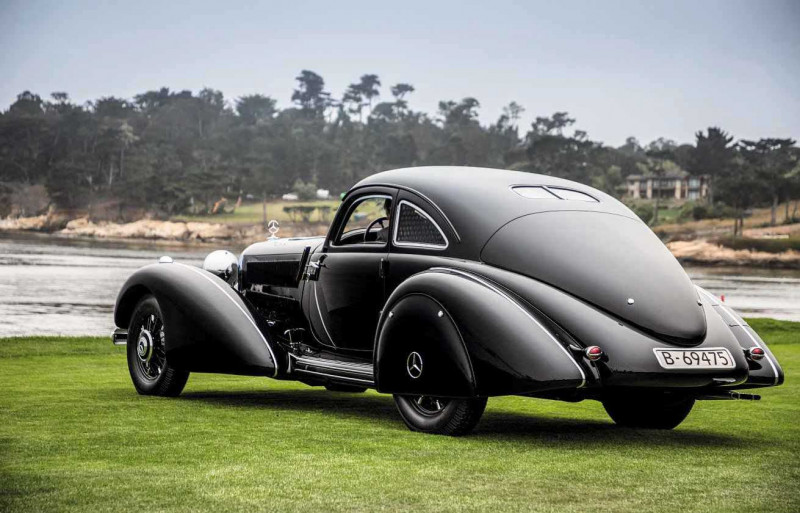
But we digress, the origins of the Autobahn-Kurier date back to the beginning of 1934, when Wilhelm Haspel, head of the Mercedes-Benz Sonderwagen (special vehicles) facility at Sindelfingen, suggested building a streamlined coupe to showcase the new 500K W29 platform, with a 5.0-litre straight-eight and Roots-type supercharger that kicked in when the throttle was floored for a power boost that lasted for a few seconds to the accompaniment of a banshee wail. Its thirst increased to the extent that aircraft engine manufacturer Junkers developed a rotary-type ‘Jumo’ fuel pump for production 500Ks to ensure fuel flow when the blower cut in.
The notice was short, for the 500K was due to be unveiled at the Berlin international motor and motorcycle show in March, yet in only ten weeks Sindelfingens chief designer Hermann Ahrens and his Sonderwagen team turned Haspel’s idea into a stunning reality.
'This is the only car of its kind, and we are the second owners from new'ARTURO KELLER
There would have been aerodynamic knowledge aplenty in the Sindelfingen workshops to work out the optimum shape for the car, the sole 500K at the show, for the factory had been an aircraft works headed by the redoubtable Hanns Klemm until the post-Armistice Versailles Treaty had forbidden Germany to build military aeroplanes. Klemm, designer of high-speed military aircraft, had converted the aircraft factory into a development and manufacturing facility for new types of car bodywork, with industrialised furniture manufacture as a sideline. Ahrens had succeeded Klemm as chief designer in September 1933, and drew on the accumulated wisdom of the Sindelfingen workshops that the ideal wind-cheating profile was that of a transected teardrop, that knowledge he then applied to create his 500K Autobahn-Kurier.
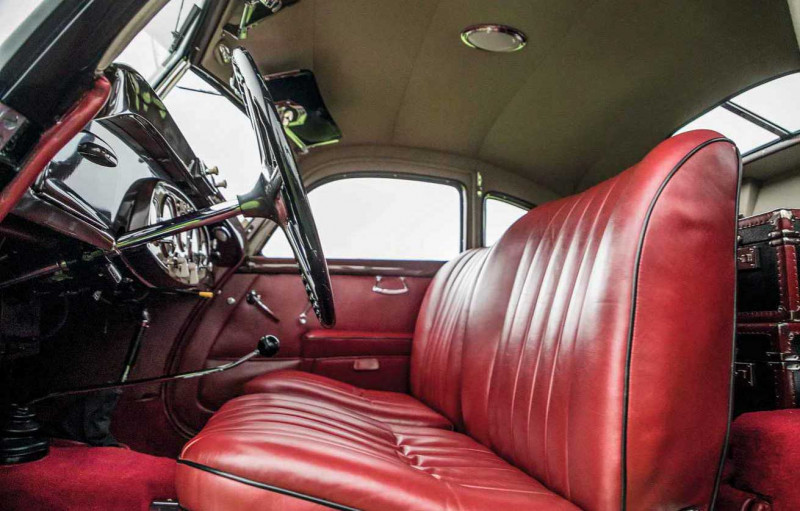
Named to conjure the image of a speedy and reliable messenger travelling the fast roads that were just beginning to be constructed in Germany, Ahrens’ Autobahn-Kurier stole the show, its sleek lines claimed to give it a top speed of 110mph against the 85mph maximum of the standard model. Four examples of the 1934 500K Autobahn-Kurier were built, says Mercedes-Benz Classic, and only two of the more powerful 540K version that followed in 1938.
Despite its glamorous name, the Kellers’ 1938 540K Autobahn-Kurier can have spent little time speeding along Germany’s newly laid motorways, for its first owner was the leading Spanish ophthalmic surgeon, Ignacio Barraquer Barraquer, who had left his native Barcelona in the mid-1930s, escaping the Spanish Civil War to practise privately in Tangier. In 1938 he spent some time working in Germany, fell for the seductively smooth lines of the Autobahn-Kurier and placed an order, even though according to Mercedes-Benz the model had been deleted from the catalogue in February 1937 following the introduction of the 540K. Whoever bought the second 540K Autobahn-Kurier remains a mystery that’s unlikely to be solved; it was almost certainly destroyed in the war.
Having taken delivery of his Autobahn-Kurier, Professor Barraquer set off with his wife for a driving tour of the Mediterranean littoral, somehow avoiding the fighting in Spain to cross into North Africa, driving through Libya and Egypt before shipping the car back across the Mediterranean to Genoa from Alexandria, they must have got back to Barcelona before the autumn of 1939, in time to avoid the outbreak of World War Two, in which Spain remained neutral.
Interviewed in 2004 by Mercedes enthusiast Bernd Loosen of Toronto, Professor Barraquers son Joaquin — a third-generation optometrist — recalled that the trip proved trying on the car, which blew a gasket in the Libyan desert. Undeterred and in the heat of the desert sun, Barraquer got out the toolkit, removed the cylinder head, replaced the head gasket and reset the valve clearances. Where he found a source ofwater in the desert was not revealed, nor do we know how he kept the desert sand from being ingested by the thirsty engine, which consumed petrol at a rate between 8mpg and 10.5mpg. One wonders, too, about the quality of fuel then dispensed by the roadside pumps of North Africa...
the poor roads were hard on the dampers and tyres, and when a puncture occurred, the professor merely remarked that the car was dancing a little! Jacking up the Mercedes, he unshipped the spare (there were two) from the locker in the tail and changed the wheel.
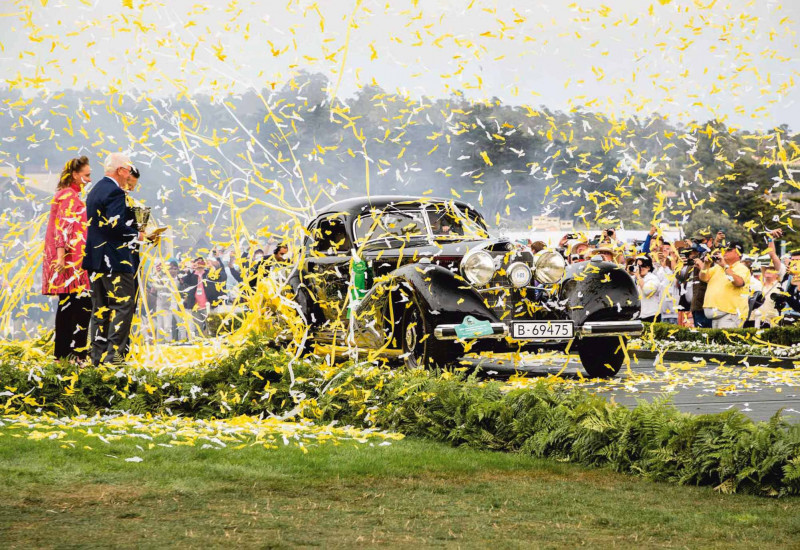
Incidentally, that considerable weight in the tail could have been the cause of a memorable high-speed gilhooley on the road during another tour near Grenoble in Eastern France recalled by Joaquin Barraquer: ‘We suddenly skidded and found ourselves with the back pointing where the front end should have been...’
And certainly Ignacio Barraquer liked to drive hard and fast, as his son told Bernd Loosen in 2004: ‘I sat comfortably and without a care in the world beside him, hitting 170km/h [105mph]. It was a car he really enjoyed, which he used as much as possible. No-one else was ever allowed to drive it, and he never had an accident. He preferred to drive without the bumpers — he didn’t want to get them scratched!
‘Another time we were on the road from Rome to Naples, and my father was driving at full speed when we noticed an Alfa Romeo catching us. No way would my father be overtaken, so he hit the compressor, but for some reason the car didn’t react. My father didn’t think that was funny, but salvation came a little further down the road in the shape of a cart pulled by a donkey. As we reached the cart, we pulled up behind it, pretending to look for a safe way to overtake. Naturally the Alfa thundered right by us, but my father had saved the honour of Mercedes-Benz!
‘Once we reached Mount Vesuvius we climbed right up as far as the road allowed the car to go. Afterwards he had the car shipped from Naples to Barcelona: he did not want the car damaged in any way.
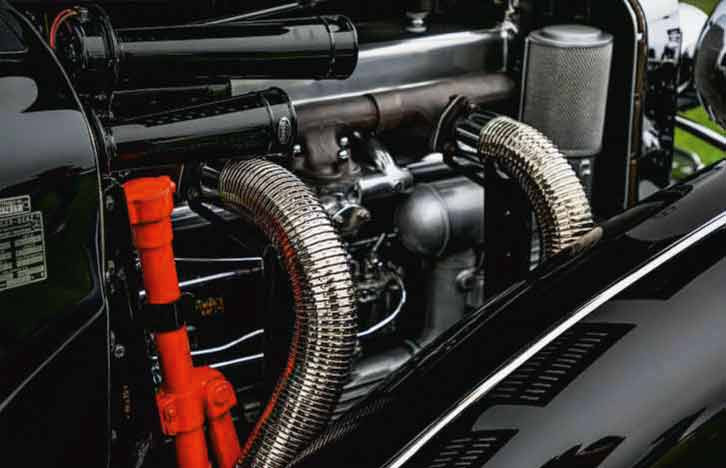
‘Those were different times, different cars, different ways of driving than today. I well remember how hot the inside of the car could become, that did not in the least disturb my father, the drivers were still sporty then; today we can’t imagine driving without air conditioning!’
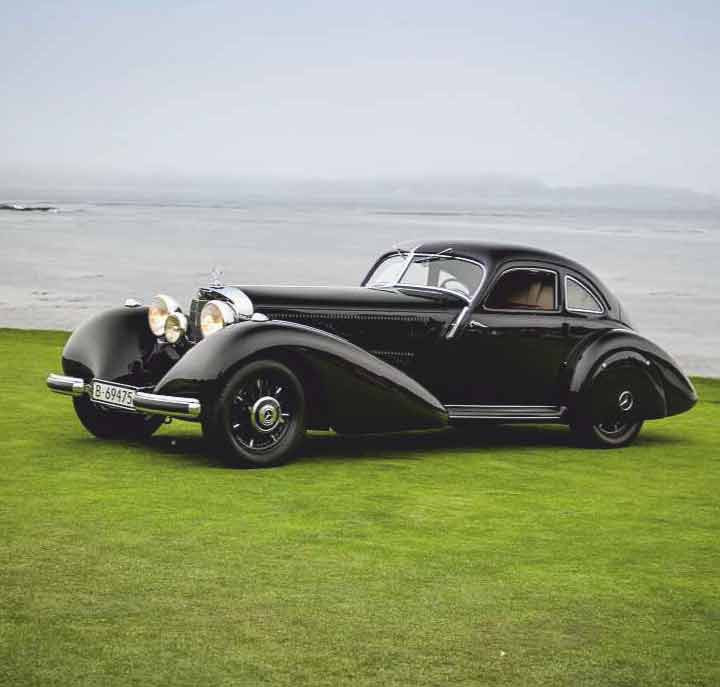
In the 1950s, when it became harder to find spare parts, the Autobahn-Kurier was laid aside in favour of a new 300S. It was given to Ignacio Barraquers son-in-law, but the parting proved too much, so Barraquer bought it back. Fortuitously perhaps, for shortly afterwards his son-in-law passed away.
The Mercedes eventually passed to his son Joaquin, who kept it for old times’ sake, at one stage lending it to the Antic Club of Catalunya for exhibition in their clubhouse, but after its whereabouts were revealed in 2004, Joaquin Barraquer received an offer he couldn’t refuse from a broker in America and the Autobahn-Kurier crossed the Atlantic, where it entered the world-class Keller Collection and was consigned to the workshops of ace restorer Paul Russell near Boston.
Surprised by the car’s remarkable originality, Russell remarked: ‘After disassembly, we discovered that the body had been repainted black and the interior reupholstered, not at all surprising considering Professor Barraquers heavy usage, the engine and drivetrain were all there, with the exception of some updated or replaced items consistent with roadside repairs.’
It was, perhaps, inevitable that the Autobahn-Kuriers second owner should be Arturo Keller, whose love of Mercedes-Benz stems from his early life in Mexico. ‘Mercedes-Benz cars have always been very special for me since I was young. Watching them win the Panamericana race, we decided to make them the core of the collection.’ that collection includes many impeccable examples of Mercedes-Benz; a 1927 SS Armbruster Cabriolet from the Keller stable was voted third best to his Autobahn-Kurier (which also took the ‘Elegance in Motion’ Award) in the Mercedes-Benz Pre-War class at Pebble Beach, a possibly unique achievement.
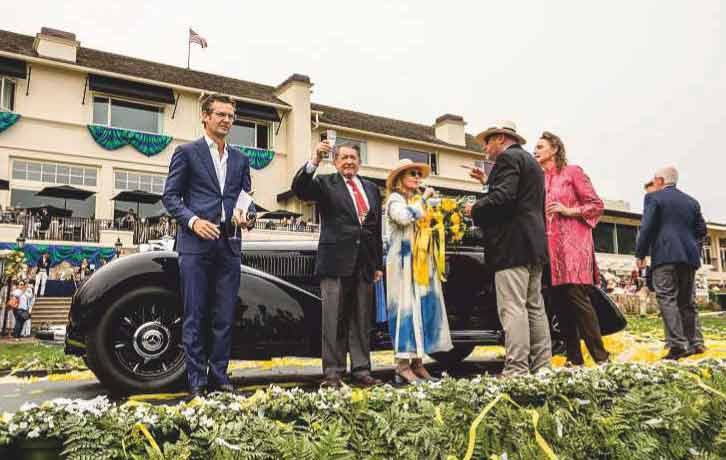
The Kellers believe in driving their cars, whether on the private road that winds through their winery estate or on the highway. Comments Arturo: ‘this Autobahn- Kurier won “Best of Show” at the Concours d’Elegance of America in 2011, crowning that with the Louis Vuitton Classic “Best of the Bests of Show” Award presented at Monte-Carlo in 2012. After accepting that prize, we drove the Autobahn-Kurier from Monte-Carlo over the Alps to Venice on the Louis Vuitton Classic Serenissima Run. This trip was an epic journey, and Mercedes-Benz must have agreed — later that year, the company honoured me with “the Star Driver Award”.
‘Winning the Pebble Beach Concours is my triple crown, this is the only remaining car of its kind, and we are the second owners from new. It’s a very special car, and we are very happy!’
Right, above and below Streamlined shape isn’t surprising, given the aerodynamic expertise at Mercedes-Benz’s Sindelfingen workshops; interior is suitably grand.
Right Confetti time! The Kellers’ 540K Autobahn-Kurier takes centre stage in the winners’ enclosure, claiming Best of Show at the 2021 Pebble Beach Concours.
1938 Mercedes-Benz 540K Autobahn-Kurier W29
- Engine 5401cc OHC monobloc straight-eight, twin-updraught carburettor, engageable Roots-type supercharger
- Max Power 115bhp @ 3500rpm; 180bhp with supercharger engaged
- Max Torque 259lb ft @ 2200rpm; 366lb ft with supercharger engaged
- Transmission Four-speed manual, semi-automatic change on top, rear-wheel drive
- Steering Worm and nut
- Suspension
- Front: double wishbones, coil springs, hydraulic dampers.
- Rear: swing axles, trailing arms, coil springs, hydraulic dampers
- Brakes Hydraulic drums with Bosch servo-assistance
- Weight 2502kg
- MPG 8
- 0-62mph 11.0sec
- Top speed 105mph


